Want to start reading at the beginning of the trip? Click here.
Dinner in Chongqing, Oct. 22
Returning from Dazu after a long day on the bus, we checked in to our hotel (a Marriott) and had the evening to ourselves. John, Hannah, Carola, Dick, and I headed out about 6:30 with the name of a restaurant that someone had seen in the Rough Guide. It appeared to be just around the corner, but, after questing stops in several places and a lot of hand-gesture directions—people pointing down the street and, a few minutes later, back up the same street—we gave up on it and looked for something authentic, like a place where only Chinese people were eating.
Looking for the restaurant we never found.
In Sichuan, a province famous for its spicy food, there’s a local dish called “hot pot.” (There’s also Mongolian hot pot, which we sampled with Haili in Beijing.) Here, the emphasis is on the first of those two words—in more ways than one. The pot itself is a kettle of spiced broth at the center of the table, into which the diner dumps various uncooked items ranging from sliced raw pork, lamb, or chicken (or shrimp or whatever’s handy—it’s said that if it has four or more legs, it can be eaten in China) to tofu, bok choi, mushrooms, and noodles. If you’re thinking “fondue,” you’re in the ballpark, but the only real similarity is the novelty of cooking at the table. We are not at The Melting Pot.
Hot pot—not ours, but similar.
On a street that had several restaurants, we chose one pretty much at random. It was brightly lit (atmosphere is not a feature of Chinese eateries) and clearly featured hot pot. After we were seated in the middle of the room—soon to be a sort of theater in the round—a young waiter was assigned to our table because, apparently, he had been exposed to English, which is not to say that he could speak it. On our side of the language divide, John became our spokesperson because he had studied a year of Chinese in college, many years ago. (There was also a badly stained pidgin-English menu touting all sorts of delicacies, such as chicken feet and assorted internal organs of small rodents.) Relying on John and the eager waiter, we learned the basics—that there is a mild broth and a spicy broth—or you can get a combo with a portion of each. That sounded good. For comestibles, we ordered conservatively: pork, mushrooms, noodles, and some vegetables.
Getting help with our order.
All of the other diners watched us carefully. It was clear that we were to be the evening’s entertainment.
Two kettles arrived and an electric fire was lit beneath the center of the table, inches from our knees. The spicy broth must have had two pounds of chopped-up red peppers roiling around in it. Cascades of capsaicin climbed aboard the rising vapors, making our noses run even before we took a bite of food. The milder broth was milky opaque, so you couldn’t see what was lurking in its depths. Black pepper and onion, I think. And something else quite aromatic.
Noodles came first in little bricks (frozen? dried?) that the waiter, smiling helpfully, dropped into the hot broth. Apparently, they had to cook a while to escape from their blocky little prisons. When released, they puffed up into discrete strings as thick as your pinky and as long as your arm. What to do? By now, the broth was at a rolling boil; our noodles alternately swam to the surface and dove to the bottom faster than you could say “chopsticks.” Which, by the way, was what we were expected to use to extract them—and everything else—from the peppery depths.
Here’s how that went: Each of us was issued a rice bowl (sans rice) and another little bowl of dipping sauce, which started out mild but rapidly took on the character of the hot pot itself. None of us could get the damn noodles out of the pot until a patron from the next table kindly intervened with a demonstration.
Wielding John’s chopsticks like a kung-fu master, he snagged a noodle and threw a coil of it over the edge of the hot pot into John’s rice bowl. The secret technique came next: Quickly slide your chopsticks back down the noodle into the broth and tug a little bit more if it over the edge, repeating rapidly as if reeling in a fish (or an eel, as the case may be), until most of the enormous noodle rests in your bowl. At a certain point, by some sort of gravitational miracle, the rest of it siphons neatly out of the pot and plops into the bowl.
Once the entire yard-long thing is nestled in front of you, it’s a simple matter of letting it cool a bit, finding one end, inserting it in your mouth with the chopsticks, and slurping it in until your gorge is full. If there’s too much noodle for one mouthful, bite it off, swallow what you’ve got, find another end, and repeat.
In this way, we polished off three or four bricks of noodles. The neighborly demo was extremely helpful, but when attempted by unskilled Americans, this noodle exercise is akin to a one-year-old eating his first birthday cake. In other words, a big mess. Our friend from the next table kept nodding and smiling encouragingly, but we knew he had to be laughing inside.
After mastering noodles, cooking and eating the rest of our meal was easier. You tossed in what you wanted and pulled out something vaguely similar from another part of the pot. There was no way to know what was yours and what was someone else’s, but no matter. Before long, even the milder broth was contaminated with chili juice and there was no escaping the capsaicin. The bemused waiter kept bringing more beer to quench our fires—and more thin little paper napkins (except in better restaurants, napkins are hard to come by in China) to staunch the dripping mess we were making between the pot and our pathetic little bowls.
It was a really tasty meal and the five of us had a lot of fun. The bill came in at 91 yuan—about $12—and that was mostly beer. We left a tip for the waiter—something he may not have expected because tipping is quite unusual in China, especially in a down-home place like this. I wish we could have tipped our helpful neighbor too, but I suspect he was already well compensated by the show we had provided.
After dining, we walked for an hour, looking at the bright lights and smart shops in the area near the Victory Monument—the heart of Chongqing’s downtown shopping district. As on Beijing’s Wangfujing St., the sidewalks were jammed with hip young Chinese in stylish outfits, strolling up and down the avenues. There were fewer Westerners than in Beijing, and I noticed more smiles and eye contact, a greater acknowledgment of our presence in the throng. Here are a few pictures of the kinds of things we saw on the street that night.
Bright lights, big city. That’s the Victory Monument on the left.
Funny, they don’t look Chinese.
A big department store. Buy a cell phone? Everyone has one.
His-and-hers pajamas—cat and mouse theme. Cute!
About a block from the hotel, I noticed a barbecue stand with a short line of Chinese watching a cook prepare little meat-on-a-stick treats. We watched for a while, until I got up the nerve to order one. The cook nodded knowingly and the woman next to me gave me a sidelong glance. On the grill was a piece of processed meat, 1/8″ thick and about the size of a No. 10 envelope. As it sizzled on the hot brazier, various sauces were applied from squeeze bottles. I paid 4 yuan—about 75 cents—and waited for my piece to be done, but the woman next to me apparently wanted to get on with the fun and politely handed me one of the two skewers that she had just purchased. How kind, I thought, taking my first bite and nodding my thanks.
About to make a big mistake.
My mouth exploded. I love spicy food, but this was the hottest, most electric thing that ever passed my lips. My tongue felt like it was on fire, buzzing with the peppery heat. I don’t remember the woman’s reaction—only my own. I retreated around the corner with my friends, giving Dick a bite. Then I sat down on a wall and ate the rest of the meat off the skewer. I wanted the full experience. It left me gasping and spitting. OK, I thought, the hot pot featured chili peppers to the max, but this is an order of magnitude more spicy. It was a feeling that I will never forget—like one never forgets the feeling of 110 volts from a light socket or the pain of slamming your finger in a car door. This was what I had come to Sichuan for—the authentic Sichuan heat.

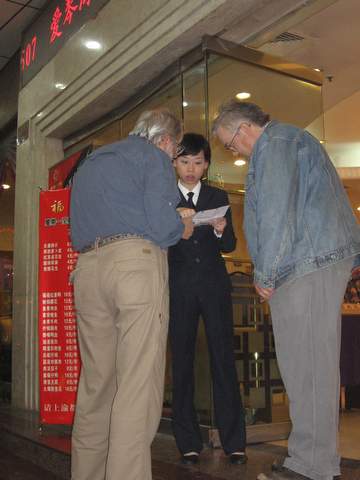
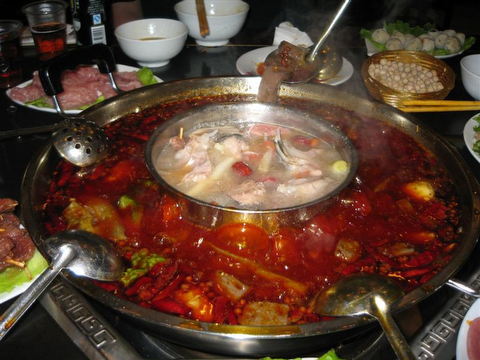
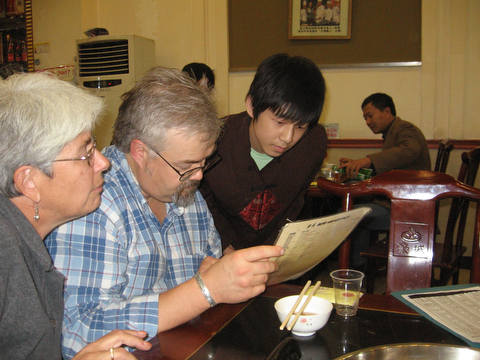
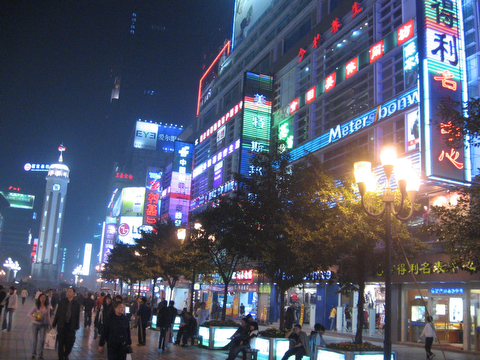
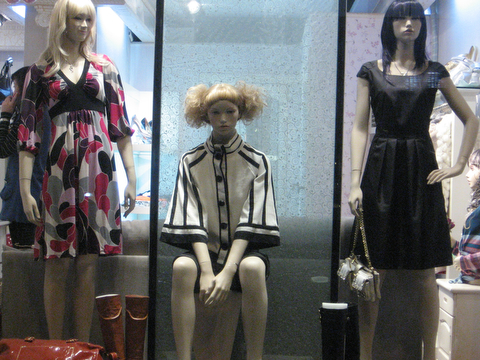
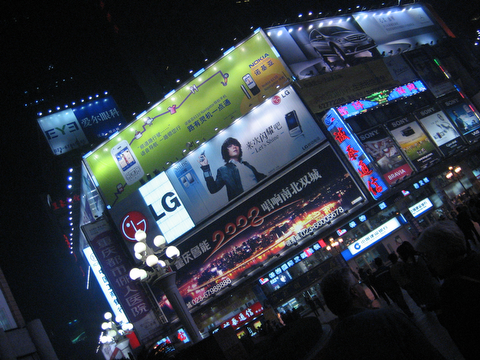
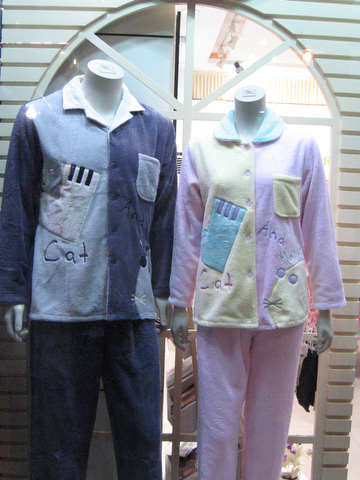
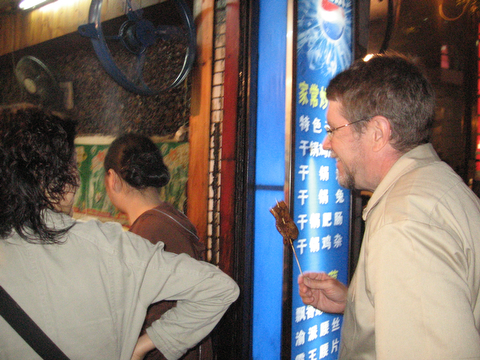
a great story .. that hotpot looks unbelievable and the way you described eating the noodles was hilarious.. felt like i was there
hi, i’m from singapore (not in china). i’m a chinese too. i just happened to stumble upon your blog while looking for photos for my project on the Yellow River.
i see you’ve went to china. it is very hilarious to us chinese when we see someone foreign tackle something so simple to us.
if you eat it regularly, you’ll get used to the spiciness.
though it wasn’t any help to my project, i’m happy to read your blog. hope you’ve had a great experience in china.
hello! cheese up there is my classmate. singapore is an awesome place, ever been? XD your blogging style is quite interesting, i have to say, and glad to know people are enjoying other cultures :D
(don’t fall for fake chinese words! not everything made of randomly joined lines is chinese!)
Fantastic article – Hope to visit once more
Hi, I’m a Chinese student studying in the UK. I’m from Chongqing. I randomly opened the webpage and saw your great stories. It was amazing. I felt like I was sitting next to you. Haha, it was so interesting to hear your experience of hotpot, which is my favourite food. Thank for sharing.